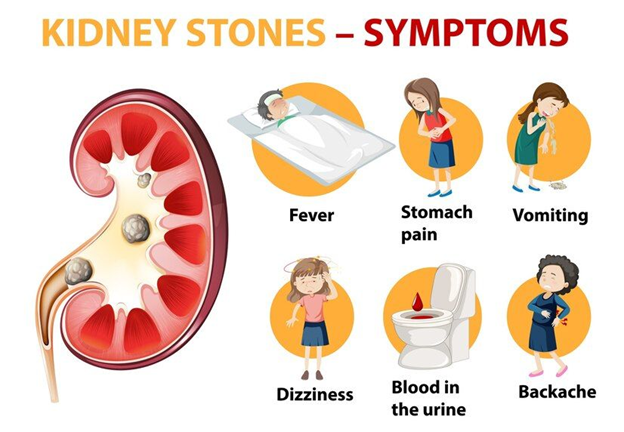Kidney stones are a painful reality for many, but recognizing kidney stones symptoms early can mean quicker relief. As more people worldwide report cases of kidney stones, it’s crucial for everyone to get familiar with the symptoms. Awareness translates to fast diagnoses and effective treatment, helping to ward off severe consequences. With kidney stone cases on the rise, knowing what signs to look for can spare you discomfort and keep you healthy. Whether it’s learning about the common manifestations of kidney stones or understanding kidney stones and symptoms, a little knowledge goes a long way in ensuring you receive prompt care.
What Are Kidney Stones?
Kidney stones are hard deposits made of minerals and salts that form in your kidneys. They develop when your urine is concentrated, allowing minerals like calcium, oxalate, and uric acid to crystallize. These minerals stick together, eventually forming stones if left unchecked. According to statistics, about 1 in 11 people are likely to get kidney stones at some point. They are more common in men than women, and risk increases with age. Understanding these elements paints a clear picture of why staying hydrated and maintaining a balanced diet is imperative.
Types of Kidney Stones and Their Impact
Kidney stones come in various types. The most common are calcium oxalate stones. Others include:
- Uric acid stones: Often associated with acidic urine.
- Struvite stones: Can appear after a urinary tract infection.
- Calcium phosphate stones: Less common and linked to certain metabolic conditions.
- Cystine stones: Rare and typically hereditary.
Each type has unique characteristics influencing symptoms and treatment. For instance, while larger stones may necessitate medical procedures, smaller ones might pass naturally but still cause sharp pains. Recognizing the type aids in accurate diagnosis and optimal management.
Understanding Kidney Stones Symptoms
Several symptoms of kidney stones can signal their presence:
- Intense, cramping pain in the back and side, moving to the lower abdomen and groin.
- Frequent urination, or a persistent urge.
- Blood in the urine, appearing pink, red, or brown.
- Nausea or vomiting.
- Cloudy or foul-smelling urine.
- Fever and chills, especially when an infection is present.
Even tiny stones can cause significant pain and discomfort, which vary from person to person. Pain intensity often correlates with stone movement within your urinary tract. It’s essential to note that while some may not show overt signs, any symptom should be a prompt to contact a healthcare professional. Ignoring them could lead to more severe health issues.
Distinguishing Symptoms of Kidney Stones from Other Conditions
Kidney stones symptoms and those of other conditions can often overlap. For example, urinary tract infections or muscular issues may cause similar discomfort. This overlap makes a professional check-up vital to ensure you receive proper treatment. A doctor’s assessment, including tests like urine or imaging scans, can conclusively determine if you’re dealing with stones or another condition.
Steps After Suspecting You Have Kidney Stones
If you suspect symptoms of kidney stones, here’s a step-by-step approach:
- Take note of your symptoms.
- Stay hydrated but avoid caffeine or alcohol.
- Seek medical advice if severe pain occurs or symptoms persist.
- A doctor might recommend an ultrasound or CT scan to visualize any stones.
- Expect blood or urine tests to check for stones or other causes.
Identifying symptoms early and consulting a doctor helps tailor an effective treatment plan. Early intervention is key to avoiding complications.
Addressing Myths and Providing Fact-Based Insights
Misconceptions persist despite widespread information about kidney stones. One common myth is that only poorly hydrated individuals develop stones; however, factors like diet also play a significant role. By understanding these cycles, you can better prevent recurrence. Trusting credible sources and seeking professional advice guides better management and prevention practices.
Prevention and Lifestyle Choices
Preventing stones starts with lifestyle changes. Here’s what you can do:
- Drink plenty of water daily.
- Limit salt and animal protein intake.
- Incorporate more fruits and vegetables in your diet.
These changes can significantly lower the chance of stone formation. Those with recurrent stones might need custom dietary plans. It’s vital to maintain these habits consistently to support kidney health and prevent future issues.
Pain Management and Home Remedies
To manage kidney stone pain at home, you can:
- Drink water to help flush out the stones.
- Apply heat on the painful area using a heating pad.
Always consult a doctor for persistent pain. Home remedies are temporary relief measures, and medical supervision ensures no underlying problem goes unnoticed.
Complications and Advanced Treatments
Untreated kidney stones may lead to complications such as infections or kidney damage. Fortunately, medical advancements offer effective solutions. Procedures like shock wave therapy break down stones non-invasively, reducing the risk of complications. Following medical advice post-treatment aids recovery, emphasizing the need to address kidney stones promptly.
Conclusion: Taking Action Against Kidney Stones
In summary, recognizing kidney stone symptoms promptly helps avert serious health issues. Prevention lies in lifestyle choices and early medical consultation. With knowledge and proactive action, most find that kidney stones are manageable. Prioritize kidney health and consult professionals regularly to curb risk factors effectively.

